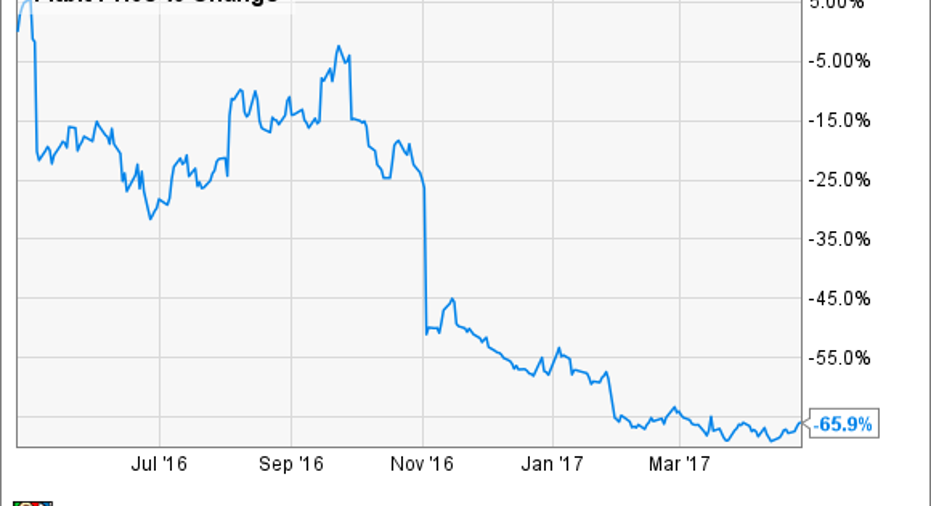What I'm Watching When Fitbit Reports Earnings

Fitness-wearable device brand Fitbit (NYSE: FIT) will announce earnings May 3 after the market closes. Investors are reeling from Fitbit's huge miss in fourth-quarter expectations, and the company is on the defensive.
Image source: Fitbit.com
Fitbit started this year with bloated channel inventory, reduced 2017 revenue expectations, grand plans for a smartwatch, and a corporate reorganization. The companyis depending on device sales through its retail partners to buy the company time to get back to growth and stop the seemingly endless slide the stock has experienced over the past year.
Following are some key stats for the company, along with a list of four key questions investors need to be answered.
Stats on Fitbit
| Market Cap | $1.35 billion |
| Cash | $706 million |
| Revenue Estimate | $280 million |
|
Change From Year-Ago Revenue |
(45%) |
Data source: Fitbit. Chart by author.
Are promotions from the holiday season done?
Last quarter, Fitbit booked $83 million in costs for channel rebates, seller promotions, and a return reserve to move the inventory in the retail stores that didn't sell over the holiday season. As Ipreviously discussed, Fitbit's management aggressively seeking to get the inventory position back in balance in the first half of the year and wants to streamline its product portfolio to make room for a smartwatch. Clearing out channel inventory is important to allow for new products such as the Alta HR and to transition to Fitbit's reduced set of product offerings.
If Fitbit has to take additional writedowns this quarter to move the excess inventory, it could delay new launches and potentially affect Fitbit's pricing power longer-term.
Is revenue per device declining further?
I've called revenue per device the one metric for Fitbit investors to watch. Fitbit had been able to grow revenue per device an amazing 69% since 2012, bucking the idea that the company's wearables could become a commodity like Garmin GPS trackers. But looking at the quarterly trend for this metric, you'll notice the peak in Q1 2016 has declined almost back to 2015 levels with the holiday season write-offs.
Data from Fitbit's earnings reports. Chart by author.
Without the $83 million in one-time charges revenue per device would have been a respectable $101 in the fourth quarter. Since this metric measures what Fitbit sells to the company's retail partners, looking at how this number stacks up this quarter should give investors a good idea of whether the company is able to maintain its pricing power going forward.
Are people buying Fitbit trackers?
Investors are getting increasingly concerned about Fitbit's ability to sell more fitness trackers. Six out of the past seven quarters have seen declines in unit sales growth.
Data from Fitbit's earnings reports. Chart by author.
In the fourth-quarter earnings call, James Park, Fitbit's CEO, said the innovator and early adopter markets in the U.S. were "saturated" and indicated that for Fitbit to be successful, the company would need to grow the "overall U.S. connected health and fitness tracker category." That doesn't sound like an easy task, with fourth-quarter unit sales down 28% in the United States.
Fitbit has projected first-quarter revenue to be $270 million to $290 million, which would put unit sales between 3.1 million and 3.3 million -- if the revenue per device number can hold from last quarter.
This reduced number of device sales brings the units-sold number back to a 2014 level. While James Park has described 2017 as a "transition" year, the company needs to sell enough devices to give management time to execute on its plans. If Fitbit can't sell 3 million devices in the first quarter, it'll be a red flag for investors.
Is Fitbit making any revenue from Enterprise Health?
In March, Fitbit announced an executive shakeup and an organization change to formally align its business into two areas: consumer health and fitness, and enterprise health. The announcement said Enterprise Health would "expand on the company's early successes in working with insurance companies, employers, health systems, and other healthcare partners." As my colleague Leo Sunhas pointed out, these efforts haven't yet materialized into revenue streams.
Fitbit has a planted a number of seeds that could grow revenue: coaching features that could drive subscription revenue or deals with medical-device companies, insurance companies, or corporate wellness programs, all of which could drive additional device sales. So far, none of these efforts have driven enough revenue for Fitbit management to call them out on an earnings report. I'll be watching for any management comments providing evidence of additional sources of revenue growth.
Fitbit doesn't need a home run this quarter. A base hit to stay in the game will be enough.
10 stocks we like better than FitbitWhen investing geniuses David and Tom Gardner have a stock tip, it can pay to listen. After all, the newsletter they have run for over a decade, Motley Fool Stock Advisor, has tripled the market.*
David and Tom just revealed what they believe are the 10 best stocks for investors to buy right now... and Fitbit wasn't one of them! That's right -- they think these 10 stocks are even better buys.
Click here to learn about these picks!
*Stock Advisor returns as of April 3, 2017
Brian Withers owns shares of Fitbit. The Motley Fool owns shares of and recommends Fitbit. The Motley Fool has a disclosure policy.



















